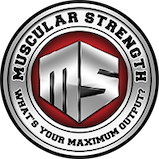
Herman Nation,
As some of you may know already, I tore my left bicep along the distal tendon (elbow side) doing switch grip deadlifts the end of November. It was not due to poor form or too much weight just stretching my muscle fibers beyond their limit. The good news was the tendon was fine but muscle tears are a different kind of injury and how they heal and what you must do immediately after it happens are critical to a successful recovery. Muscle tears are called Strains and torn ligaments are Sprains. There are 3 types: 1,2,3 with 3 being a complete tear of the muscle belly. Type 1 and 2 have varying degrees of fibers torn with 2 being 15%-50% and type 1 less than 15%. The more fibers torn, the longer the re-hab and the more strength lost initially. I thought I would share what I have learned and what I am doing to rehab it:
The Bad:
Muscle tissue is contractile tissue - meaning it stretches and then returns to normal to create force. Muscles, however, do not heal like bone. When a bone breaks, it is replaced with new bone that is stronger than the old. Muscles do not do this. When a muscle is torn, it eliminates the dead and torn muscle fibers. Stem cells within the muscle are then stimulated to lay down a small layer of new muscle sacomeres. The rest of the tear is filled in with scar tissue from fibroblasts. When a muscle tears, a large hematoma forms (internal bleeding, clotting factors, fibroblasts) that begin the healing process. The problem is that scar tissue is neither contractile and flexible nor as strong as muscle fibers. The result is you can have a deformity in the muscle at the tear and may experience strength loss because the longer and more fibers a muscle has, the more force it can generate. Scar tissue doesn't do this.
The Ugly:
Most muscle tear deformities are permanent. Surgery doesn't work because stitching muscle tissue is like trying to sew hamburger meat together. Only when a muscle has completely torn in half is surgery required. These are called Type 3 strains and the muscle is never the same again. Type 1 and Type 2 (which is what I had) can heal on their own and the muscle will recover to 100% (Type 1) and near 100% for Type 2.
The Good:
The body has an amazing power to recover especially when given rest and proper nutrition. It even learns to compensate for damaged or weakened muscles by recruiting more fibers from surrounding muscles so as to maintain strength. Proper training, rehabilitation, diet, and rest are critical. Also, the FIRST 72 HOURS are the most important to your recovery and long term prognosis. What you do in this window will determine how well you heal and how much scar tissue you have - the more scar tissue the more chance of re-injury.
The First 72 Hours:
Upon realizing you have torn a muscle, immediately stop whatever you are doing and get ice on the muscle. Alternate every 20 minutes - 20 minutes with ice, no ice for 20 minutes, then ice again for 20 minutes, etc. DO NOT touch, massage, or apply any heat. Immobilize the muscle and use ace bandages to protect and compress the area. You will have a lot of internal bleeding and swelling. You may or may not see a lot of bruising depending on how many capillaries were damaged and how gravity directs th blood flow. For mw, my forearm was black and blue but my bicep was fine - gravity forced all the internal bleeding down into my forearm. While this bleeding and the eventual hematoma it forms are critical for healing, you need to minimize swelling so as to speed up healing. Ice is the only way to do this.
After 72 Hours:
The pain and/or swelling should be stabilized and not getting worse. If they are getting worse, get to a doctor/hospital ASAP. By the 4th day you can now start cycling ice with heat. You also should try to gently massage the muscle if it does not hurt too much to do so. By doing this you will accomplish two things: minimize the amount of scar tissue formed and help the scar tissue heal inline with your muscle fibers. Scar tissue grows all over the place not in any specific pattern this is why people with this injury who don't treat it properly always re-injur the area. By th 7th day, try to do some Very Light exercises and/or lifting. This helps align the scar tissue and lengthen it. As the injury gets better, stretching is critical to lengthen and straighten the scar tissue as much as possible. You need to start using and stretching the injured muscle as soon as you can within your pain limits. If you don't, the scar tissue will heal weak and contracted. The key is NEVER stretch or lift anything if it causes pain. You have to work gradually until the pain goes away. Therefore using NSAIDs or pain relievers is not recommended during re-hab because pain is your healing and progress feedback.
With proper rest, diet, and re-hab, you can be back to 100% as quickly as 2 weeks (type 1 strain) to 2 months (type 2 strain).
John


